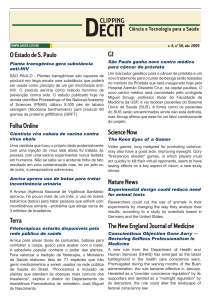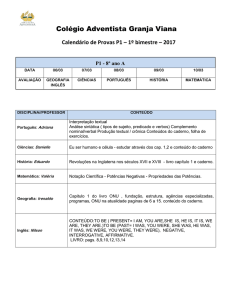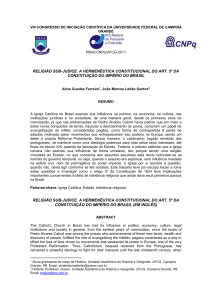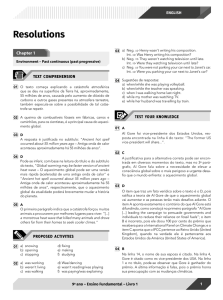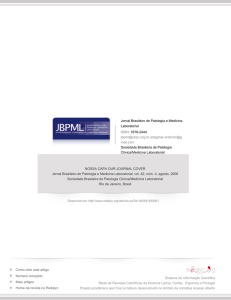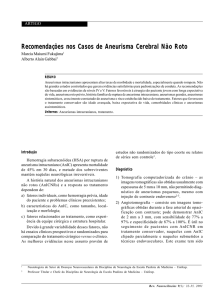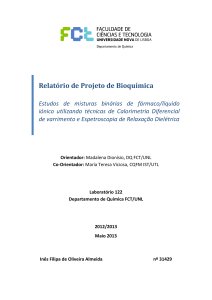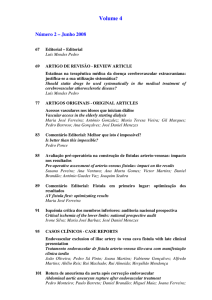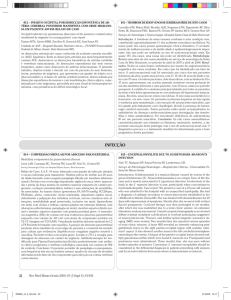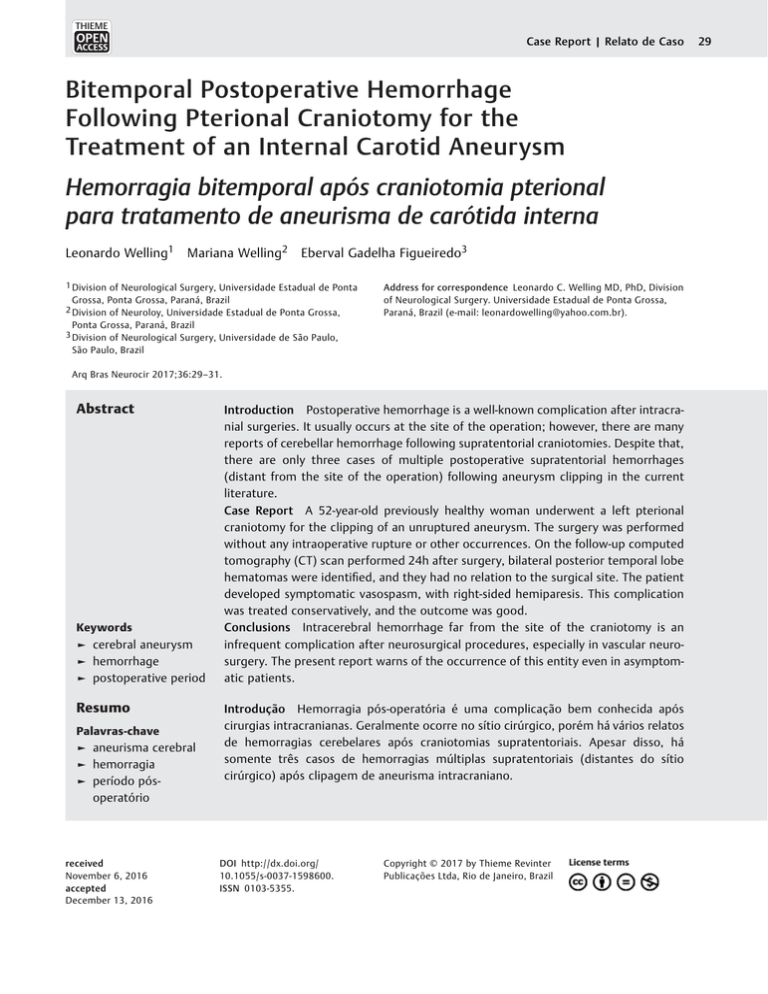
THIEME
Case Report | Relato de Caso
Bitemporal Postoperative Hemorrhage
Following Pterional Craniotomy for the
Treatment of an Internal Carotid Aneurysm
Hemorragia bitemporal após craniotomia pterional
para tratamento de aneurisma de carótida interna
Leonardo Welling1
Mariana Welling2
Eberval Gadelha Figueiredo3
1 Division of Neurological Surgery, Universidade Estadual de Ponta
Grossa, Ponta Grossa, Paraná, Brazil
2 Division of Neuroloy, Universidade Estadual de Ponta Grossa,
Ponta Grossa, Paraná, Brazil
3 Division of Neurological Surgery, Universidade de São Paulo,
São Paulo, Brazil
Address for correspondence Leonardo C. Welling MD, PhD, Division
of Neurological Surgery. Universidade Estadual de Ponta Grossa,
Paraná, Brazil (e-mail: [email protected]).
Arq Bras Neurocir 2017;36:29–31.
Abstract
Keywords
► cerebral aneurysm
► hemorrhage
► postoperative period
Resumo
Palavras-chave
► aneurisma cerebral
► hemorragia
► período pósoperatório
received
November 6, 2016
accepted
December 13, 2016
Introduction Postoperative hemorrhage is a well-known complication after intracranial surgeries. It usually occurs at the site of the operation; however, there are many
reports of cerebellar hemorrhage following supratentorial craniotomies. Despite that,
there are only three cases of multiple postoperative supratentorial hemorrhages
(distant from the site of the operation) following aneurysm clipping in the current
literature.
Case Report A 52-year-old previously healthy woman underwent a left pterional
craniotomy for the clipping of an unruptured aneurysm. The surgery was performed
without any intraoperative rupture or other occurrences. On the follow-up computed
tomography (CT) scan performed 24h after surgery, bilateral posterior temporal lobe
hematomas were identified, and they had no relation to the surgical site. The patient
developed symptomatic vasospasm, with right-sided hemiparesis. This complication
was treated conservatively, and the outcome was good.
Conclusions Intracerebral hemorrhage far from the site of the craniotomy is an
infrequent complication after neurosurgical procedures, especially in vascular neurosurgery. The present report warns of the occurrence of this entity even in asymptomatic patients.
Introdução Hemorragia pós-operatória é uma complicação bem conhecida após
cirurgias intracranianas. Geralmente ocorre no sítio cirúrgico, porém há vários relatos
de hemorragias cerebelares após craniotomias supratentoriais. Apesar disso, há
somente três casos de hemorragias múltiplas supratentoriais (distantes do sítio
cirúrgico) após clipagem de aneurisma intracraniano.
DOI http://dx.doi.org/
10.1055/s-0037-1598600.
ISSN 0103-5355.
Copyright © 2017 by Thieme Revinter
Publicações Ltda, Rio de Janeiro, Brazil
29
30
Bitemporal Postoperative Hemorrhage Following Pterional Craniotomy for Internal Carotid Aneurysm
Treatment Welling et al.
Relato do Caso Paciente feminina, de 52 anos, previamente hígida, foi submetida a
craniotomia pterional para clipagem de aneurisma não roto. A cirurgia ocorreu sem
ruptura intraoperatória ou outra intercorrência. Na tomografia de crânio de controle,
realizada 24h após o procedimento, 2 hematomas temporais posteriores foram
identificados sem relação com o sítio cirúrgico. A paciente posteriormente desenvolveu vasoespasmo sintomático, com hemiparesia direita, mas essa complicação foi
tratada conservadoramente, e teve boa evolução clínica, sem déficit residual.
Conclusões Hemorragias intracranianas distantes do sítio cirúrgico são complicações
infrequentes, especialmente em neurocirurgia vascular. O presente caso adverte para a
ocorrência dessa complicação mesmo em pacientes assintomáticos.
Introduction
Postoperative hemorrhage is a well-known complication after
intracranial surgeries.1 It usually occurs at the site of the
operation; however, there are many reports of cerebellar
hemorrhage following supratentorial craniotomies.2 Out of
all intracerebellar hemorrhages following supratentorial craniotomies, aneurysm clipping is involved in 32% of the cases.2
Despite that, there are only three cases of multiple postoperative supratentorial hemorrhages (distant from the site of
the operation) following aneurysm clipping in the current
literature.1,2 In this report, the authors describe and
discuss the possible pathophysiological events in this rare
complication.
for aneurysm clipping that was performed without any intraoperative rupture or other occurrences. After the surgery, the
patient was completely awake, and had no deficits.
On the follow-up computed tomography (CT) scan performed 24h after surgery, bilateral posterior temporal lobe
hematomas were identified, and they had no relation to the
surgical site (►Fig. 2).
A complete hematological examination was performed, and
the results were normal. During the follow-up, the CT scans
showed the progressive reabsorption of both hematomas, but
at the 12th postoperative day, the patient developed a symptomatic vasospasm with right-sided hemiparesis. This complication was treated conservatively, and the outcome was good.
Discussion
Case Report
A 52-year-old previously healthy woman had an isolated
episode of seizure. During the evaluation, magnetic resonance
angiography and conventional angiography were performed.
A left posterior communicating aneurysm was identified
(►Fig. 1). The patient underwent a left pterional craniotomy
Fig. 1 Preoperative angiography. Left internal carotid aneurysm
(posterior communicating segment).
Arquivos Brasileiros de Neurocirurgia
Vol. 36
No. 1/2017
Intracerebral hemorrhage remote from the site of the craniotomy is an infrequent complication after neurosurgical
procedures.3 These hemorrhages are often worrying and
life-threatening complications.2 Different mechanisms
have been proposed, some authors consider that aggressive
Fig. 2 Postoperative tomography. Bitemporal hemorrhage distant
from the craniotomy site.
Bitemporal Postoperative Hemorrhage Following Pterional Craniotomy for Internal Carotid Aneurysm
Treatment Welling et al.
intraoperative cerebrospinal fluid removal can cause a
brain shift that contributes to intracerebral hemorrhages.
Others suggest that the surgical procedure itself induces
coagulative modifications. A history of hypertensive
peaks during the recovery period is also involved in this
scenario.1–3
Despite the fact that none of the previously described
pathophysiological mechanisms were involved in our case,
the present study warns of the occurrence of this entity even
in asymptomatic patients.
References
1 Fukamachi A, Koizumi H, Nukui H. Postoperative intracerebral
hemorrhages: a survey of computed tomographic findings after
1074 intracranial operations. Surg Neurol 1985;23(06):575–580
2 Marquardt G, Setzer M, Schick U, Seifert V. Cerebellar hemorrhage
after supratentorial craniotomy. Surg Neurol 2002;57(04):241–251, discussion 251–252
3 Figueiredo EG, de Amorim RL, Teixeira MJ. Remote cerebellar
hemorrhage (zebra sign) in vascular neurosurgery: pathophysiological insights. Neurol Med Chir (Tokyo) 2009;49(06):229–233,
discussion 233–234
Arquivos Brasileiros de Neurocirurgia
Vol. 36
No. 1/2017
31

